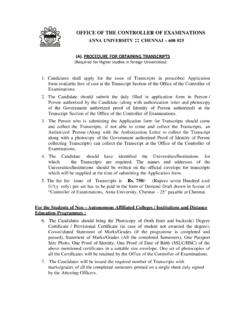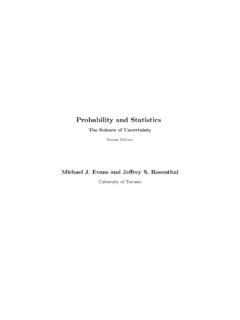Transcription of APA Citation Style - Cornell University Library
1 Prepared by Cornell University Library PSEC Documentation Committee November 2002; revised December 2008 1 APA Citation Style refers to the rules and conventions established by the American Psychological Association for documenting sources used in a research paper. APA Style requires both in-text citations and a reference list. For every in-text Citation there should be a full Citation in the reference list and vice versa. The examples of APA styles and formats listed on this page include many of the most common types of sources used in academic research. For additional examples and more detailed information about APA Citation Style , refer to the Publication Manual of the American Psychological Association and the APA Style Guide to Electronic References. Also, for automatic generation of citations in appropriate Citation Style , use a bibliographic Citation management program such as Refworks or EndNote. Some software products, such as Microsoft Word 2007 have Citation software built in.
2 Reference Citations in Text In APA Style , in-text citations are placed within sentences and paragraphs so that it is clear what information is being quoted or paraphrased and whose information is being cited. Examples: Works by a Single Author The last name of the author and the year of publication are inserted in the text at the appropriate point. from theory on bounded rationality (Simon, 1945) If the name of the author or the date appear as part of the narrative cite only missing information in parentheses. Simon (1945) posited that In 1945 Simon posited that Works by Multiple Authors When a work has two authors, always cite both names every time the reference occurs in the text. In parenthetical material join the names with an ampersand (&). as has been shown (Leiter & Maslach, 1998) In the narrative text, join the names with the word "and." as Leiter and Maslach (1998) demonstrated APA Citation Style CUL Pub.
3 No. 8 Prepared by Cornell University Library PSEC Documentation Committee November 2002; revised December 2008 2 When a work has three, four, or five authors, cite all authors the first time the reference occurs. Kahneman, Knetsch, & Thaler (1991) found In all subsequent citations per paragraph, include only the surname of the first author followed by "et al." (Latin for "and others") and the year of publication. Kahneman, et al. (1991) found Works by Associations, Corporations, Government Agencies, etc. The names of groups that serve as authors (corporate authors) are usually written out each time they appear in a text reference. (National Institute of Mental Health [NIMH], 2007) When appropriate, the names of some corporate authors are spelled out in the first reference and abbreviated in all subsequent citations. The general rule for abbreviating in this manner is to supply enough information in the text Citation for a reader to locate its source in the Reference List without difficulty.
4 (NIMH, 2007) Works with No Author When a work has no author, use the first two or three words of the work's title (omitting any initial articles) as your text reference, capitalizing each word. Place the title in quotation marks if it refers to an article or chapter of a book. Italicize the title if it refers to a book, periodical, brochure, or report. on climate change ("Climate and Weather," 1997) Guide to Agricultural Meteorological Practices (1981) Anonymous authors should be listed as such followed by a comma and the date. on climate change (Anonymous, 2008) Specific Parts of a Source To cite a specific part of a source (always necessary for quotations), include the page, chapter, et cetera (with appropriate abbreviations) in the in-text Citation . (Stigter & Das, 1981, p. 96) De Waal (1996) overstated the case when he asserted that "we seem to be reaching .. from the hands of philosophers" (p. 218). If page numbers are not included in electronic sources (such as web-based journals), provide the paragraph number preceded by the paragraph symbol or the heading and following paragraph.
5 (M nnich & Spiering, 2008 9) Prepared by Cornell University Library PSEC Documentation Committee November 2002; revised December 2008 3 Reference List References cited in the text of a research paper must appear in a Reference List or bibliography. This list provides the information necessary to identify and retrieve each source. Order: Entries should be arranged in alphabetical order by authors' last names. Sources without authors are arranged alphabetically by title within the same list. Authors: Write out the last name and initials for all authors of a particular work. Use an ampersand (&) instead of the word "and" when listing multiple authors of a single work. Smith, J. D., & Jones, M. Titles: Capitalize only the first word of a title or subtitle, and any proper names that are part of a title. Pagination: Use the abbreviation p. or pp. to designate page numbers of articles from periodicals that do not use volume numbers, especially newspapers.
6 These abbreviations are also used to designate pages in encyclopedia articles and chapters from edited books. Indentation *: The first line of the entry is flush with the left margin, and all subsequent lines are indented (5 to 7 spaces) to form a "hanging indent". Underlining vs. Italics *: It is appropriate to use italics instead of underlining for titles of books and journals. Two additional pieces of information should be included for works accessed online . 1. Internet Address**: A stable Internet addresses should be included and should direct the reader as close as possible to the actually work. If the work has a digital object identifier (DOI), use this. If there is no DOI or similar handle, use a stable URL. If the work s URL is not stable, as is often the case with online newspapers and some subscription-based databases, use the home page of the site you retrieved the work from. 2. Date: If the work is a finalized version published and dated, as in the case of a journal article, the date within the main body of the Citation is enough.
7 However, if the work is not dated and/or is subject to change, as in the case of an online encyclopedia article, include the date that you retrieved the information. * The APA has special formatting standards for the use of indentation and italics in manuscripts or papers that will be typeset or submitted for official publication. For more detailed information on these publication standards, refer to the Publication Manual of the American Psychological Association, or consult with your instructors or editors to determine their Style preferences. ** See the APA Style Guide to Electronic References for information on how to format URLs that take up more than one line. Examples: Articles in Journals, Magazines, and Newspapers References to periodical articles must include the following elements: author(s), date of publication, article title, journal title, volume number, issue number, and page numbers. Journal Article, one author, accessed online Ku, G.
8 (2008). Learning to de-escalate: The effects of regret in escalation of commitment. Organizational Behavior and Human Decision Processes, 105(2), 221-232. Prepared by Cornell University Library PSEC Documentation Committee November 2002; revised December 2008 4 Journal Article, two authors, accessed online Sanchez, D., & King-Toler, E. (2007). Addressing disparities consultation and outreach strategies for University settings. Consulting Psychology Journal: Practice and Research, 59(4), 286-295. Journal Article, more than two authors, accessed online Van Vugt, M., Hogan, R., & Kaiser, R. B. (2008). Leadership, followership, and evolution: Some lessons from the past. American Psychologist, 63(3), 182-196. Article from an Internet-only journal Hirtle, P. B. (2008, July-August). Copyright renewal, copyright restoration, and the difficulty of determining copyright status. D-Lib Magazine, 14(7/8). Journal article from a subscription database (no DOI) Colvin, G.
9 (2008, July 21). Information worth billions. Fortune, 158(2), 73-79. Retrieved from Business Source Complete, EBSCO. Magazine article, in print Kluger, J. (2008, January 28). Why we love. Time, 171(4), 54-60. Newspaper article, no author, in print As prices surge, Thailand pitches OPEC- Style rice cartel. (2008, May 5). The Wall Street Journal, p. A9. Newspaper article, multiple authors, discontinuous pages, in print Delaney, K. J., Karnitschnig, M., & Guth, R. A. (2008, May 5). Microsoft ends pursuit of Yahoo, reassesses its online options. The Wall Street Journal, pp. A1, A12. Books References to an entire book must include the following elements: author(s) or editor(s), date of publication, title, place of publication, and the name of the publisher. No Author or Editor, in print Merriam-Webster's collegiate dictionary (11th ed.). (2003). Springfield, MA: Merriam-Webster. Prepared by Cornell University Library PSEC Documentation Committee November 2002; revised December 2008 5 One Author, in print Kidder, T.
10 (1981). The soul of a new machine. Boston: Little, Brown & Company. Two Authors, in print Frank, R. H., & Bernanke, B. (2007). Principles of macro-economics (3rd ed.). Boston: McGraw-Hill/Irwin. Corporate Author, Author as Publisher, accessed online Australian Bureau of Statistics. (2000). Tasmanian year book 2000 (no. ). Canberra, Australian Capital Territory: Author. Retreived from /0/CA25687100069892CA256889000CA9FC/$ Edited book Gibbs, J. T., & Huang, L. N. (Eds.). (2001). Children of color: Psychological interventions with culturally diverse youth. San Francisco: Jossey-Bass. Dissertations References for dissertations should include the following elements: author, date of publication, title, and institution (if you accessed the manuscript copy from the University collections). If there is a UMI number or a database accession number, include it at the end of the Citation . Dissertation, accessed online Young, R.




